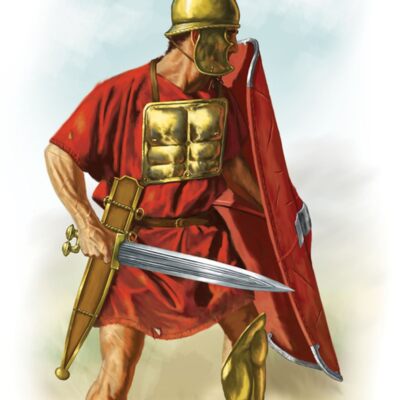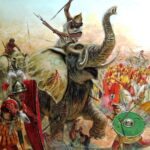Chapters
Battle of the Metaurus River (207 BCE) was a turning point in the Second Punic War in Italy. After the pogrom of Hasdrubal’s army, Hannibal had to give up further fighting in the Apennine Peninsula.
Historical background
Second Punic War was full of manoeuvres and battles that were a model for future generations of the military. Especially the “lightning war” Hannibal, his masterfully fought battles inspired many leaders of the 19th and 20th centuries. The Second Punic War became the subject of research and discussion of successive generations of historians. In the common mind, this conflict is most associated with the Battle of Cannae and the first period of the war. However, less known are the declining episodes of the Second Punic War, such as the clash at Metaurus, ending the last great offensive of the Carthaginians in Italy.
After Hannibal’s campaign in Italy, culminating in victories over the Trebia, Lake Trasimeno, and at Cannae, the scales of victory slowly but steadily tilted to the side of the relentless Roman republic. The triumphant Punic commander was unable to ensure the victory of his armies on other battlefronts. In Sicily, the Romans dealt a blow to the enemy, capturing strategically important Syracuse after a long siege. Luck was not favourable for the Carthaginians in Spain, where African Scipio conquered New Carthage. Hannibal, blocked by Roman armies in southern Italy, needed outside support. The Romans also felt exhaustion from many years of fighting, because as early as 209 BCE out of 30 Latin colonies, which were strongholds of Rome in Italy, as many as 12 refused to provide troops and cash. The republic’s Etruscan allies also expressed dissatisfaction.
The Carthaginian authorities tried to take advantage of this situation to turn the tide of the war. Hasdrubal Barkas was to travel from the Iberian Peninsula to Italy to reunite with his brother. Like Hannibal once, he would enlist his troops with recruits among Gauls, Rome’s ancient enemies. After the defeat at Baikula, the Punic chief drove the army through the Tagus, Durus and Ebro valleys to reach the slopes of the Pyrenees. He tried to avoid the routes along the Mediterranean, patrolled by the Romans. In southern Gaul, he enlisted mercenaries among the local tribes for gold. 8,000 Ligurians also joined the ranks of the invasion army. The march of the new Carthaginian army did not go unnoticed by the inhabitants of Massilia, who informed the Senate about it. Roman agents, using the Massili’s ties with some Gaul chiefs, learned of Hasdrubal’s intention to enter Italy in the spring of 207 BCE. Conscription has also affected the coastal colonies that have been released from military service so far. The passage over the Adriatic Sea was protected by the 2-legionary army of praetor L. Porcjus Licynus in Ariminum, and the routes to Etruria were also protected by the 2-legion group of the propreator G. Terentius Varro. Another propreator of Quintus Fulvius Flaccus checked Hannibal with his 2 legions in Bruttium, and Kw. Claudius Flamen occupied the vicinity of Taranto with the same force. The 1st legion of G. Hostilius Tubulus was assigned to protect the Campaign.
The military actions against Hasdrubal’s army were to be carried out by consul 207 BCE, M. Liwius Salinator. His colleague, G. Claudius Nero, had a draw with Hannibal in the south of Italy. However, both consuls did not have friendly relations, because Livius, the hero of the war with the Illyrians, was accused and condemned by Nero for dishonesty in the distribution of the spoils. For a long time, he could not get over this insult, and it was necessary to exhort the senators that both gentlemen should act in harmony for the good of the country.
Meanwhile, the Punic commander, after entering the Po valley, besieged Placencja, which, however, fiercely resisted him. Hasdrubal sent some horsemen with letters to Hannibal, but these were arrested by the Romans near Taranto. The papers found on the prisoners indicated that the place of the expected connection of Hasdrubal with his brother was to be Umbria in the centre of the peninsula, perhaps near the eastern Adriatic coast. The Punic army followed a convenient and abundant food route along the Adriatic Sea, fighting sporadically with the nearest group of Roman troops under the command of Licinius. Hasdrubal, passing Fanum Fortunae, came across the combined forces of him and Salinator under Sena Gallica.
Meanwhile, Consul Nero separated from his troops a detachment of 6,000 infantry and 1,000 cavalry to support these combined armies. The march of his group was prepared in terms of logistics – food and forage were gathered in advance on the marked route of her march. The surrounding communities were also ordered to prepare carriages and draft animals for the marching troops of Nero. Nero faked an attack on the surrounding city and marched at night towards Picenum. The march was carried out quickly and efficiently, which allowed the Roman troops to enter the Salinator camp without the enemy’s knowledge. Nero sent a notification to the troops of Livy and Porcius standing under Sena Gallica, he led his troops there under the cover of the night, and individual soldiers from the camp had already led individual legionaries to their tents. The Roman armies formed a battle line, as did Hasdrubal. The latter made a reconnaissance on horseback and noticed tired horses and a larger number of legionaries in the Roman camp. The Punic chief guessed what had happened in the enemy camp. Additionally, he sent scouts who reported that the Roman camp had not been enlarged, but had heard 2 trumpet blasts in the consul’s camp and one in the praetor’s camp. Now Hasdrubal realized that he had an army of two consuls against him.
He ordered the night’s retreat to the Metaurus River, then descended via Flaminia from where one could either turn south to Hannibal or threaten Rome. However, the two guides leading his army fled, and the marchers lost their way, some, weary of the long march, lay down to sleep in the open field. The Romans began the pursuit at sunrise. First came Nero’s cavalry, then velites under the command of Porcius. Hasdrubal’s warriors found refuge on the hill, where they began setting up the camp. As Salinator arrived with the rest of his strength, the Carthaginian commander realized that the battle was inevitable and prepared his troops for the coming clash.
Battle of the Metaurus River June 22, 207 BCE
The Roman chieftains had arranged their legions in the traditional triple array of triplex acies. The left wing was commanded by Salinator, the centre was taken by the troops of Licinius, on the right-wing was the agile Nero. Presumably, the Roman cavalry was split between both ends of the front. The republic’s forces probably did not exceed 40,000 people, and they faced a much weaker opponent. Hasdrubal prepared his troops in deep formation over the uneven terrain. The left-wing, set on a hill inaccessible to the Romans, was occupied by the Gauls. Hasdrubal was aware of their straw zeal in battle and therefore assigned them a rather subordinate role in battle. Tough Ligurian soldiers stood in the centre of the formation, while on the right-wing were the best Iberians, Celtybers and probably Libyans in the entire army. Elephants were placed in front of the right-wing of Hasdrubal’s army, which was to constitute an armoured fist against the Romans. It was on his right-wing that Hasdrubal wanted to find a solution. There is no information in the sources about the Carthaginian drive.
When the battle raged, neither side could gain an advantage for a long time. Hasdrubal’s elephants on the right-wing trample the enemy ranks, frightening the Roman front line. Many legionaries were literally trampled by wild animals, and the manipulators hastati began to recede. The sight of the elephants, however, was not a surprise to the Romans, experienced in the battles with Hannibal and his “tanks of the ancient world.” So the legionaries finally managed to drive away from the thick-skinned with javelins, which began to circulate furiously between the two armies, also trampling their own ranks.
Meanwhile, on the right-wing of the Romans, the consul Nero could not attack the Celts occupying a convenient position, nor round them from the flank. He formed a column of some of his troops and led it from the rear of the front to the left-wing, commanded by Salinator. Then a volatile group of Romans emerged on the flanks of the enemy’s right wing of Iberians and Celtybers, attacking its flanks and rear. The surprised soldiers of Hasdrubal fled, leaving the exposed Ligurians out of the centre. They also could not withstand the attack of the Romans from the flank and gave way. The Gauls left on the left wing, unaccustomed to the war, did not cope with the tough Roman legionaries. In the midday heat, the Celtic warriors felt weary, which additionally determined the outcome of this clash.
Hasdrubal himself urged his men to fight for a long time and more than once turned the escapees. When – according to Livy – he lost hope of defeating the enemy, he himself threw himself into the battle and died bravely in hand-to-hand combat. After conquering the camp, the Romans captured many sleeping Gauls, in a state of wine intoxication. According to Polybius’s message, 10,000 people died from Hasdrubal’s army, and the same number was taken prisoner. Roman losses were 2,000 people. After the fighting ceased, Nero returned with his group back south and threw the severed head of Hasdrubal in front of the Carthaginian outposts. On the news of the victory in Rome, three-day prayers of thanksgiving were ordered. The commander of the victorious army, Gaius Livius Salinator, triumphed in the capital, and Nero received the honour of riding a horse next to his friend’s chariot. According to the sources, during this wonderful ceremony, it was Nero who was more applauded by the cheering people as the right architect of the victory over Metaurus.
The importance of the battle
The battle was a turning point in the war in Italy. After the pogrom of his brother’s army over Metaurus, Hannibal acknowledged his defeat in Italy. He evacuated the crews from Lucania and Metapont and withdrew to Bruttium. Anyway, even in the event of victory in this battle, the Punics could no longer turn the tide of the war. After the successes of Scipio in Spain and the stripping of the region of select Punic troops, the supply of recruits, silver and gold needed by Carthage on other battlefronts ceased. Indeed, with enormous human resources at its disposal, Rome was unbeatable. In the campaign, and especially in the battle itself, you can clearly see Nero’s talent for leading sudden manoeuvres in groups of troops, successful. Another advantage was the ability to cooperate between Roman commanders, despite their personal animosities.










